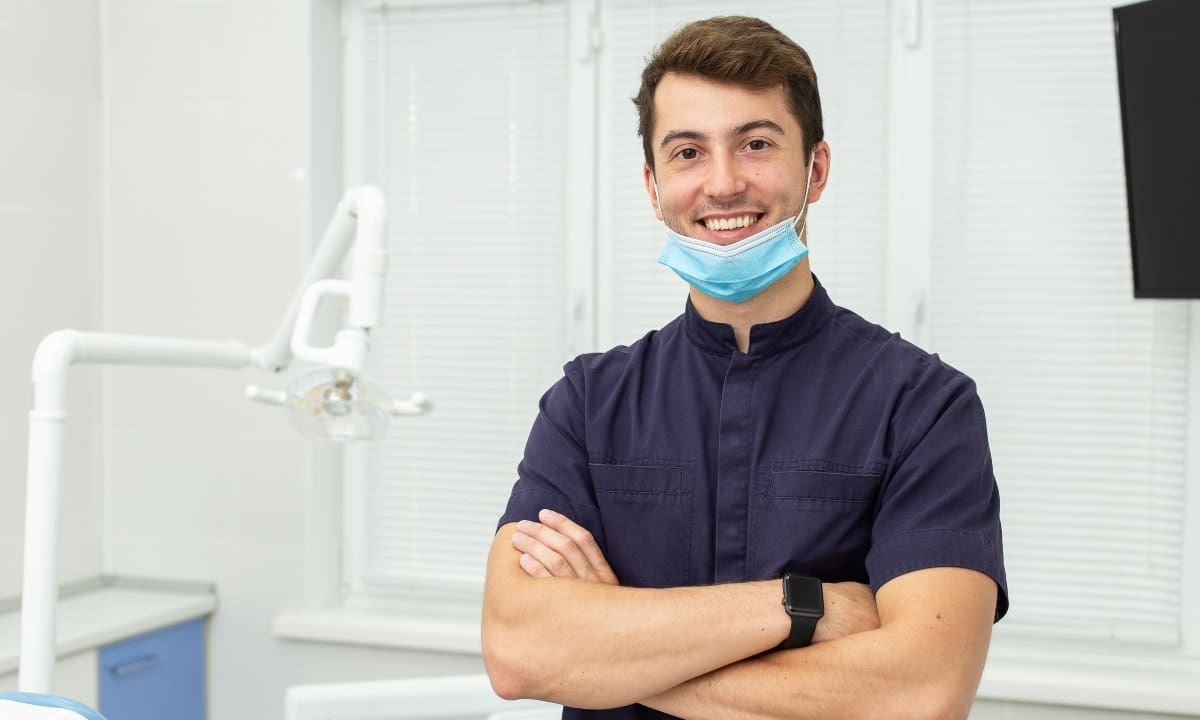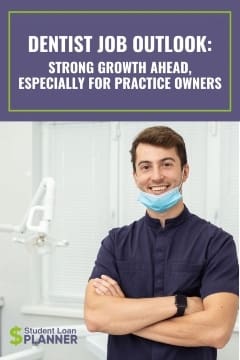
There are two factors that are most important in determining whether the dental profession is in a good state or not: how many jobs are out there (demand) and how many dentists are out there right now (supply).
To forecast whether there’s a bright or bleak future for the dental profession, we need to take a look at the projected growth — aka how many jobs are projected to come online — and how many people will enter the market as newly minted dentists (aka current dental students enrolled).
If there are more job openings than dentists to cover them, then the dentist job outlook is good. Dentists can pick their job and demand higher salaries. Conversely, if there are more dentists and fewer positions to fill, then dentists could have trouble finding a job and their employers don’t have to pay them as much.
First, let’s take a look at the job market for dentists
Dentist job outlook summary: Great demand
According to the Bureau of Labor Statistics, the market for dentists is projected to grow nicely as baby boomers age and need more complicated procedures such as implants. Job prospects for new dentists look good based on the following data:
- There were 155,000 dentist jobs in 2018.
- The Bureau of Labor Statistics projects 7% total growth over the next 10 years, which is above the average profession growth rate of 5%.
- The Health Resources and Services Administration estimates that there’s a shortage of 10,802 dentists as of 2018.
- According to the Health Policy Institute, there are about 55.4 full-time equivalent dentists per 100,000 people in the U.S. That’s about 1 dentist per 1,818 people — sounds like a nice patient base.
Where will job growth for dentists come from?
We used to focus on Baby Boomers only to figure out what demand would be, but the Millennial generation is projected to overtake it in population by 2019 or 2020.
As boomers age, they’re going to require more complex dental health procedures. They’re more likely to want to keep their teeth or get implants rather than go with dentures as their parents did. This demand means they will continue with normal dental maintenance as well as other teeth-saving procedures, which bodes well for general dentists as well as periodontists.
Millennials are also much more aware of the importance of proper dental care for their young children. They are starting to take their kids to the dentist before kindergarten age, and pediatric dentists and orthodontists could see increased demand as a result.
All in all, the market for future dentists looks strong.
Dental school applicant rate is stagnant as acceptance rates rise
Over 12,000 people applied to dental school last year. That’s up just 57 applicants since 2010.
Even with a stagnant pool of applicants, 50.6% of applicants ended up enrolling in dental school in 2017, according to the Journal of Dental Education, up from 41.2% in 2010.
The main reason for the increase in enrollment is that the seats available at dental schools have grown faster than the pool of applicants. Those seats come mainly from new dental schools entering the mix. Dental school growth may have increased, but it’s hardly on fire.
Dental school growth is slow despite expensive tuition
Dental school is one of the most expensive grad schools out there, even more expensive than medical school, so it would make sense that more schools would pop up over time to collect that expensive tuition. But growth has been really slow. There are 66 accredited dental schools in the U.S. right now. That’s up from 58 in 2010, a total increase of only 13%.
The growth of dental schools has led to more people enrolling in dental school. There were 6,148 first-year dental students in 2017, up from 5,100 in 2010. That’s only a 2.6% annualized growth rate.
With those stats, it doesn’t seem like there will be a boom of dentists graduating, which is good for dentists because more graduates would make it hard to find a job and drive dentist salaries down.

The job outlook is bright for dentists… for now
Above-average projected growth in dentist jobs and the slow growth of new dentists entering the market bodes well for current and future dentists.
What could change that dynamic?
Because dental school is one of the most expensive types of grad school, current universities could see a good return on investment if they were to start a new dental program or expand their current one. But with virtually no growth in applicants, starting or expanding a program could be risky.
If there comes a time when the number of dental school applicants grows, then more schools would be quick to enter the market and capture that high tuition.
The question is, will more people be attracted to the dental profession?
Dentists and dental specialists are among the highest compensated professions. They’re also among some of the more stable professions.
If more intelligent, hardworking people who are interested in a career in healthcare get wind of this industry dynamic and decide to apply for dental school instead of pharmacy school or medical school, for example, then that shift could ramp up the number of applicants (aka the demand to go to dental school). More applicants would lead to more schools opening up, and the market could be flooded with new dentists.
No such trend could happen overnight though. Even if a new school opened up its doors today, it would take four years for those students to graduate. Plus, some states like New York are now requiring one year of dental residency post-graduation.
It could take 10 years or more for the number of graduating dentists to outpace demand, so the dental profession’s bright future could last a decade or more.
Dentist career path is promising, especially with practice ownership
Associate dentists are in high demand right now even right out of dental school or just after residency. The average dentist we talk with here at Student Loan Planner® gets about 25% to 30% of production. That’s pretty good and can lead to a salary between $160,000 and $240,000.
But owning a dental practice can be relatively low risk with a high upside.
A solid dental practice should have a profit margin of over 40%, which is far greater than the 25% to 30% production payout. That means that a practice-owning dentist can make 33% to 50% more than a dental associate for the same work.
Yes, there is extra work involved in opening a dental practice, but the benefits of practice ownership appear to outweigh the relatively low risk. The best indicator of this is that the default rate on dental practice debt is extremely low — below 2%. By comparison, more than 50% of restaurants fail, so a restaurant is 25 times riskier than opening up a dental practice.
If you’re interested in this career path, check out Travis Hornsby’s Student Loan Planner® podcast interview with Dr. Zach Kingsberg about starting a dental practice.
Practice Loan Quote Form
Dental specialists can earn 50% more money
General dentistry is a very rewarding profession, but some dental students might want to specialize, which can really increase their income.
Most specialties in dentistry require a two- to three-year residency, but it can really pay off, even if it means making just $40,000 to $50,000 during residency. Periodontists, orthodontists, endodontists, pediatric dentists, and especially oral and maxillofacial surgeons, for example, can earn a hefty premium income compared with general dentists.
The American Dental Association did a great research study into dental specialties. Inflation-adjusted salaries are fairly stagnant, but they can earn 50% or more compared to general dentists. According to this same study, these specialists are treating more patients each year, and demand continues to rise.
Dental school loan options
Yes, dental school is expensive. We’ve done 470 consults with dentists here at Student Loan Planner®, and our average dentist client has $381,000 in loans. That’s one of the highest average debt loads by profession we’ve seen out of the more than 3,000 people covering $750,000,000 in student debt that we’ve consulted on.
Dentists have two options for student loans: They can take out federal loans, which offer a lot of repayment flexibility such as income-driven repayment and potential loan forgiveness. These kinds of loans should be taken out by 90% or more of the people going to dental school.
For those entering either a lower tuition dental school or who know they’re going to go into a specialty where they’ll be making just about their student loan balance, they could consider using private student loans rather than really costly Grad PLUS loans that have an origination fee of 4.25% plus a 7% interest rate.
Anyone who is uncertain or not entirely confident in their post-dental school career path should take out federal loans. Those who are extremely confident they’re going to go into highly compensated specialties like surgery or orthodontics and think their student debt is going to be equal to their salary could consider private loans for dental school. Remember though that private loans have to be paid back in full and don’t have that much repayment flexibility.
We are the experts on dental school student loans and debt
People entering the dental profession have bright prospects.
We’ve worked individually with 470 dentists with an average student loan debt of $381,000 to get them each a custom plan for their specific situation. So how do you decide which repayment plan is best for you as a dentist?
A general rule of thumb is that someone who owes less than 1.5 times their income in student loans (e.g., a dentist earning $200,000 who owes $300,000 or less in loans) should consider refinancing. Make sure you can afford to pay off your loans in 10 years or less and that you don’t have any eligibility for Public Service Loan Forgiveness or other loan forgiveness options.
But dentists with two times their income or more in student loans (e.g., those making $200,000 who owe more than $400,000) should explore income-driven repayment.
If you’re looking for help finding a solid plan to pay back your dental school student loans and have other questions specific to dentistry — like how to balance student loan repayment with practice ownership — we’d be happy to help. Along with potential savings, most people say they just feel relieved to have a concrete plan they understand.
Check out our flat fee planning service. If you want to share the details of your situation and learn how we could help, reach out to our team.
Refinance student loans, get a bonus in 2024
| Lender Name | Lender | Offer | Learn more |
|---|---|---|---|

|
$500 Bonus
*Includes optional 0.25% Auto Pay discount. For 100k or more.
|
Fixed 5.24 - 9.99% APR*
Variable 6.24 - 9.99% APR*
|
|

|
$1,000 Bonus
For 100k or more. $300 for 50k to $99,999
|
Fixed 5.19 - 10.24% APPR
Variable 5.28 - 10.24% APR
|
|

|
$1,000 Bonus
For 100k or more. $200 for 50k to $99,999
|
Fixed 5.19 - 9.74% APR
Variable 5.99 - 9.74% APR
|
|

|
$1,050 Bonus
For 100k+, $300 for 50k to 99k.
|
Fixed 5.44 - 9.75% APR
Variable 5.49 - 9.95% APR
|
|

|
$1,275 Bonus
For 150k+, $300 to $575 for 50k to 149k.
|
Fixed 5.48 - 8.69% APR
Variable 5.28 - 8.99% APR
|
|

|
$1,250 Bonus
For 100k+, $350 for 50k to 100k. $100 for 5k to 50k
|
Fixed 5.48 - 10.98% APR
Variable 5.28 - 12.41% AR
|
Not sure what to do with your student loans?
Take our 11 question quiz to get a personalized recommendation for 2024 on whether you should pursue PSLF, Biden’s New IDR plan, or refinancing (including the one lender we think could give you the best rate).
